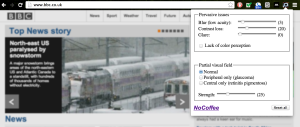Vision problems are more pervasive than most of us realize. Upwards of 285 million people worldwide are visually impaired. Many more have low or moderate visual difficulties. The number in the U.S. is expected to double by 2020, due to the aging of the baby boomer generation.
NoCoffee is a free extension for Chrome (download link), which can be helpful for understanding the problems faced by people with slight to extreme vision problems, such as:
- Low Acuity:
Some pages use very small text or click targets. While it’s true that users use built-in browser zoom or assistive technologies like ZoomText, many non-technical users do not know how. - Low Contrast Sensitivity:
Many designers use text with very low contrast, e.g. light gray text on white. Incidentally, here are some great tools for analyzing contrast on the web, and my favorite is the Snook Colour Contrast Check. - Colorblindness:
Although color use in design is definitely a good thing, it’s important to remember the maxim “do not rely on color alone”, as 7-10% of males have some form of colorblindness. Chris Campbell has a great article describing color-related design problems and solutions. - Other: Visual snow, glare and ghosting:
- Obstructed visual field:
Obstructed visual field: floaters, obstruction to one side (retinal detachment or hemanopia), obstructed central vision (glaucoma), spotty vision (diabetic retinopathy) or obstructed peripheral vision (retinitis pigmentosa or macular degeneration). Note: the simulations of partial visual fields cannot follow your eye gaze as they would in the real world.
To use NoCoffee, download and install it from the Chrome store, and then click on the extension icon in the Chrome toolbar.
Limitations:
- The simulations are not medically/scientifically accurate.
- The simulations of partial visual fields cannot follow your eyes.
- Settings are not linked to statistical probabilities, so it’s difficult to know how likely it is that NoCoffee is showing you something seen by many users. Still, the tool is helpful to get (or give) an idea of many types of vision problems.
- Currently only Google Chrome is supported (at least until more browsers fill in their CSS3 support, specifically CSS3 filters).
Inspired by the Chrometric browser, visionsimulations.com and new capabilities in CSS3.
I’d be happy to post the source code if anyone would like to port it or improve it.
As always, feedback appreciated!

Amazing!
[…] Introducing NoCoffee – Vision Simulator for Chrome […]
Great job on this! I particularly like the color deficiency selector and the blocked visual field options. I know very little about vision impairments, and I was wondering if somewhere (within the extension or elsewhere) there could be a list of “profiles” or something that are similar to some specific people’s issues. That is, i have no idea what values or combinations of pervasive issues with and without the other choices are realistic or make sense. maybe there could be a few selections that would modify several of these parameters.
Good idea.
I think I’ll be adding stuff that helps us all sort through these things … right now the UI is just a long list of possibilities. I want to add extra info, guidance and statistics to make it even more helpful.
Thanks for the feedback. Keep it coming. Feel free to review it in the Chrome store, my 2 five star reviews were accidentally deleted (by me getting frustrating with update process).
[…] NoCoffee Vision Simulator (Chrome extension) By Aaron Leventhal. “NoCoffee can be helpful for understanding the problems faced by people with slight to extreme vision problems” https://chrome.google.com/webstore/detail/nocoffee/jjeeggmbnhckmgdhmgdckeigabjfbddl NoCoffee Vision Simulator (Article) https://accessgarage.wordpress.com/2013/02/09/458/ […]